wrist/hand eval
5.0(1)
Card Sorting
1/34
Earn XP
Study Analytics
Name | Mastery | Learn | Test | Matching | Spaced |
|---|
No study sessions yet.
35 Terms
1
New cards
history
* how did this injury occur? (mechanism)
* when did you hurt your hand/wrist?
* Where does it hurt?
* Did u hear any sounds or feel a pop?
* have you injured this hand/wrist before?
* when did you hurt your hand/wrist?
* Where does it hurt?
* Did u hear any sounds or feel a pop?
* have you injured this hand/wrist before?
2
New cards
observation
* attitude of the hand
* bilateral comparison of wrist/hand (swelling, deformity, discoloration)
* palmar surface(DIP, PIP, dist. and prox. palmar, and thenar creases; hypothenar eminence and thenar eminence)
* dorsal surface (knuckles, fingernails)
* bilateral comparison of wrist/hand (swelling, deformity, discoloration)
* palmar surface(DIP, PIP, dist. and prox. palmar, and thenar creases; hypothenar eminence and thenar eminence)
* dorsal surface (knuckles, fingernails)
3
New cards
attitude of the hand
the way the hand naturally rests and bilaterally compare, naturally slightly flexed MCP and IP joints, almost parallel fingers
4
New cards
proximal palmar crease
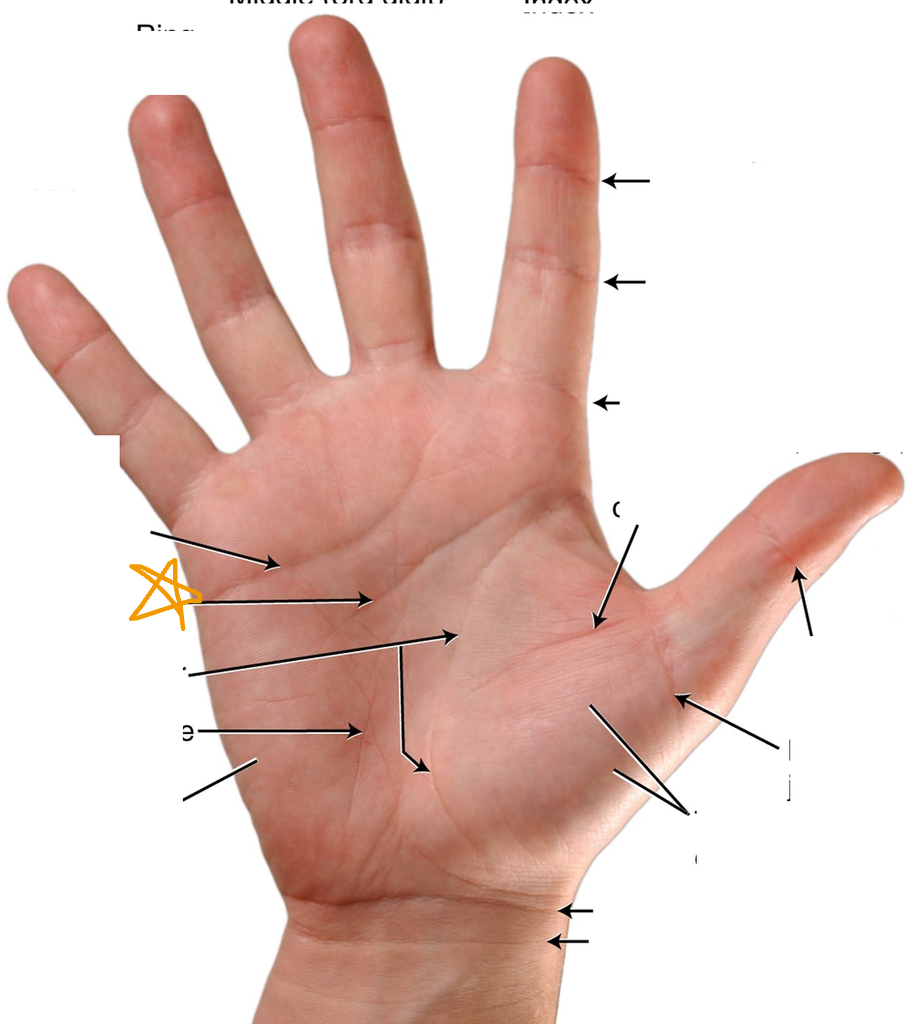
5
New cards
distal palmar crease
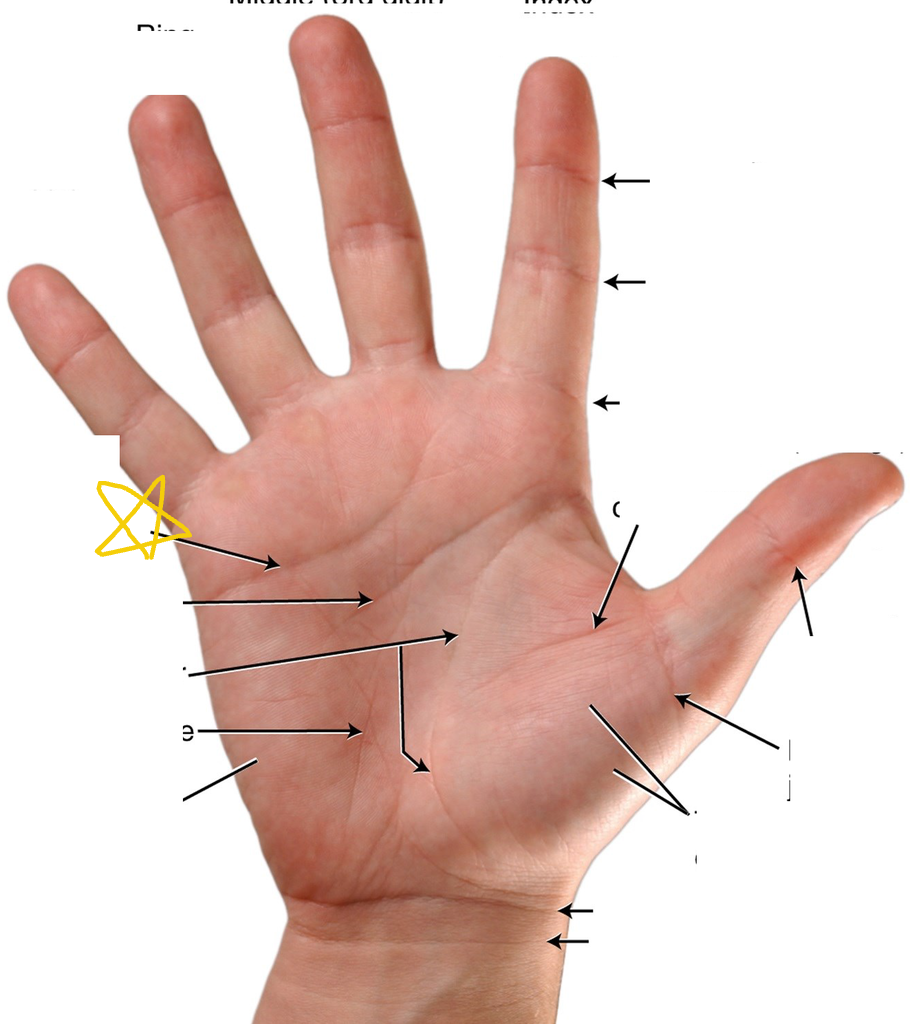
6
New cards
thenar crease
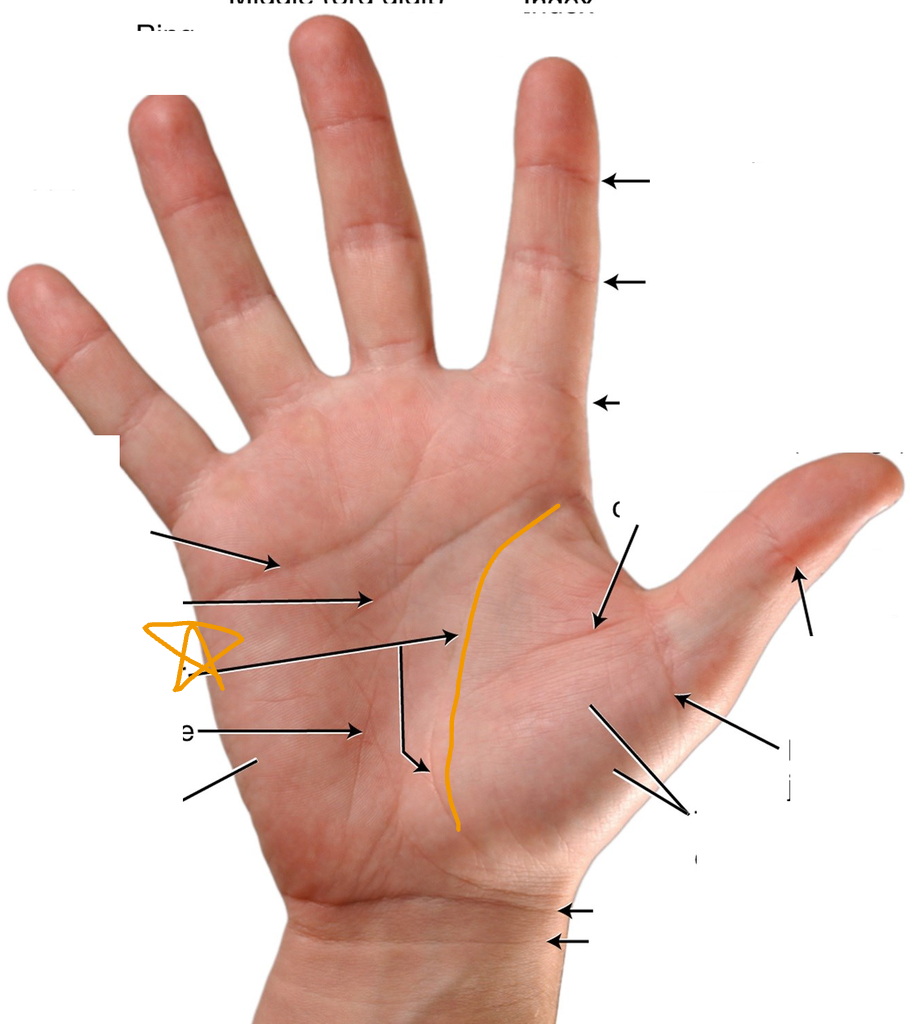
7
New cards
thenar eminence
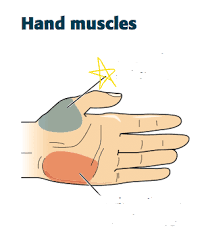
8
New cards
hypothenar eminence
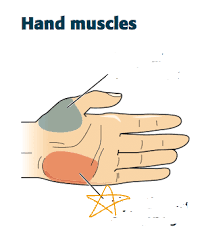
9
New cards
DIP creases
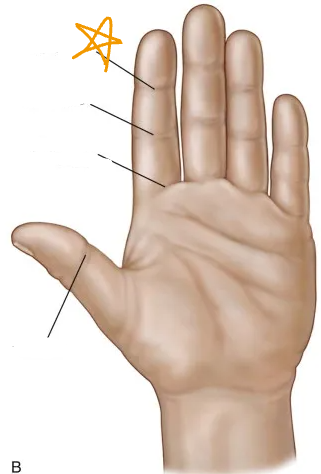
10
New cards
PIP creases
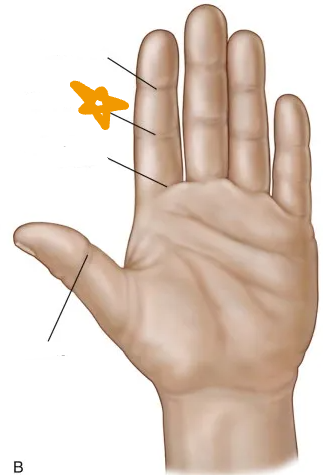
11
New cards
IP crease
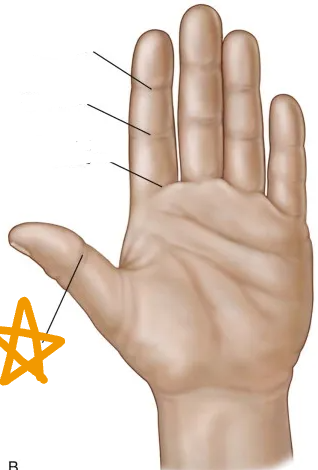
12
New cards
Palpation(palpate the following noting point tenderness, deformity, etc.)
Soft tissue
* tunnels 1-6
\----
Bony
* Radius styloid process
* ulna styloid process
* scaphoid
* trapezium
* metacarpals
* phalanges
\--
* Carpal tunnel
* Tunnel of guyon
* thenar eminence
* hypothenar eminence
* palmar aponeurosis
* tunnels 1-6
\----
Bony
* Radius styloid process
* ulna styloid process
* scaphoid
* trapezium
* metacarpals
* phalanges
\--
* Carpal tunnel
* Tunnel of guyon
* thenar eminence
* hypothenar eminence
* palmar aponeurosis
13
New cards
flexor digitorum superficialis test
goes only to middle phalanges
active
* hold other fingers in extension, especially DIP, deactivate profundus
* bend the finger
* negative if still can flex, but distal can’t bend which is normal
* positive if can’t flex
looking for flexion of PIP
active
* hold other fingers in extension, especially DIP, deactivate profundus
* bend the finger
* negative if still can flex, but distal can’t bend which is normal
* positive if can’t flex
looking for flexion of PIP
14
New cards
flexor digitorum profundus test
goes to distal joint
active
* hold PIP joint of the specific finger
* negative if DIP can flex
* positive if can’t curl the finger, might feel a tug though
active
* hold PIP joint of the specific finger
* negative if DIP can flex
* positive if can’t curl the finger, might feel a tug though
15
New cards
bunnel-littler test (intrinsic m. vs. capsule)
passive
**note**: capsule around joints doesn’t change, so it’s muscle tightness if stiff in one position, but if both positions are stiff, it’s the capsule that’s tight. changing proximal joint changes the muscle length.
PIP joint
* hyperextend MCP
* feel for pip mobility
* release and test again(w/o MCP hyperextended)
* feel for stiffness
\-
* *same amount of stiffness(resistance) in both-the tighest structure is the capsule*
* *difference of stiffness in the 2 phases-the intrinsic muscle is the tightest structure*
**note**: capsule around joints doesn’t change, so it’s muscle tightness if stiff in one position, but if both positions are stiff, it’s the capsule that’s tight. changing proximal joint changes the muscle length.
PIP joint
* hyperextend MCP
* feel for pip mobility
* release and test again(w/o MCP hyperextended)
* feel for stiffness
\-
* *same amount of stiffness(resistance) in both-the tighest structure is the capsule*
* *difference of stiffness in the 2 phases-the intrinsic muscle is the tightest structure*
16
New cards
retinacular test
passive
test for DIP joint
* hold proximal joint and feel for mobility
* then release the proximal joint and feel for difference in stiffness
\-
* *same amount of stiffness(resistance) in both-the tighest structure is the capsule*
* *difference of stiffness in the 2 phases-the retinaculum is the tightest structure*
test for DIP joint
* hold proximal joint and feel for mobility
* then release the proximal joint and feel for difference in stiffness
\-
* *same amount of stiffness(resistance) in both-the tighest structure is the capsule*
* *difference of stiffness in the 2 phases-the retinaculum is the tightest structure*
17
New cards
allen test(circulation)
for the wrist
pumping motion like 5 times, then squeeze tight around the wrist, release one artery but letting go of a finger, then redo with releasing the other one(reference from anatomical position, duh: medial side is the ulnar artery, lateral is the radial)
Even if one is blocked the other should help w/circulation, helps figure out which artery isn’t supplying blood
positive sign-not seeing refill
pumping motion like 5 times, then squeeze tight around the wrist, release one artery but letting go of a finger, then redo with releasing the other one(reference from anatomical position, duh: medial side is the ulnar artery, lateral is the radial)
Even if one is blocked the other should help w/circulation, helps figure out which artery isn’t supplying blood
positive sign-not seeing refill
18
New cards
finklestein test
test for dequervain’s
* dequervain’s disease-tenosynovitis around anatomical snuffbox area
* test for inflammation of the sleeve around tendons
*tenosynovitis-inflammation of sleeve around tendons*
* tuck thumb in(flex) and flex fingers and **slowly** ulnar deviate
* should feel similar on both hands(pain)
* positive-not the same feeling on both hands
* dequervain’s disease-tenosynovitis around anatomical snuffbox area
* test for inflammation of the sleeve around tendons
*tenosynovitis-inflammation of sleeve around tendons*
* tuck thumb in(flex) and flex fingers and **slowly** ulnar deviate
* should feel similar on both hands(pain)
* positive-not the same feeling on both hands
19
New cards
tinel sign
tap over median nerve(passes through carpal tunnel) neurological symptoms to the fingers (median nerve supplies)
20
New cards
phalen’s test
tell them to put backs of hands together and press together for 30 seconds, compressing it, after 30 seconds, positive sign is neuro symptoms of median nerve
21
New cards
tenosynovitis
inflammation of sleeve around tendons
22
New cards
dequervain’s disease
tenosynovitis around anatomical snuffbox area
23
New cards
tests for carpal tunnel syndrome(name 2)
* tinel sign test
* phalen’s test
* phalen’s test
24
New cards
palpate the radius styloid process
lateral when the hand is in anatomical position, can palpate the distal tip and there’s a small but distinct groove on lateral edge
25
New cards
palpate the ulna styloid process
bumpy process on the medial side, visible too, easier palpation by radially deviating and having the extensor carpi ulnaris tendon contract
26
New cards
palpate the scaphoid(carpal navicular)
in anatomical snuffbox, distal to the radial styloid process, ulnar deviate to make it palpable
27
New cards
palpate the trapezium
distal to the snuffbox to palpate near its articulation with the 1st metacarpal; (to feel the trapezium and MT articulation, flex and extend thumb)
28
New cards
palpate metacarpals
palpate with thumb, index, and middle fingers, the dorsal and radial sides are easy to palpate
29
New cards
palpate the phalanges
palpate for differences(14 per hand), feel and check for swelling, tenderness, symmetry…
30
New cards
palpate the tunnel of guyon
at the hook of hamate on palmar side of hand, crossing of a line between the 4-5 digits and 1-2 digits
31
New cards
palpate the carpal tunnel
deep to palmaris longus(palmaris longus can be seen by opposing thumb to pinkie, some people don’t have it), proximal side is pisiform, navicular and the distal side is hamate hook and trapezium, home for median nerve and finger flexors to pass through
32
New cards
palpate the thenar eminence
base of thumb, dominant hand may have a more pronounced eminence, median nerve supplies to muscles of the thenar eminence
33
New cards
palpate the hypothenar eminence
proximal to pinkie to pisiform, ulnar nerve supplies the muscles by/in the hypothenar eminence
34
New cards
palpate the palmar aponeurosis
the palmar fascia extends to base of fingers, probe to check for thickened areas on the palmar side of the hand
35
New cards
tunnels 1-6 and the tendons
tunnel 1-abductor pollicis longus, extensor pollicis brevis
tunnel 2-extensor carpi radialis longus, extensor carpi radialis brevis
tunnel 3-extensor pollicis longus
tunnel 4-extensor digitorum, extensor communis, extensor indicis
tunnel 5-extensor digiti minimi
tunnel 6-extensor carpi ulnaris
tunnel 2-extensor carpi radialis longus, extensor carpi radialis brevis
tunnel 3-extensor pollicis longus
tunnel 4-extensor digitorum, extensor communis, extensor indicis
tunnel 5-extensor digiti minimi
tunnel 6-extensor carpi ulnaris